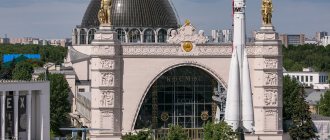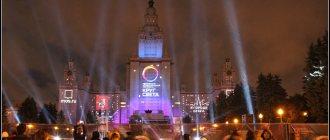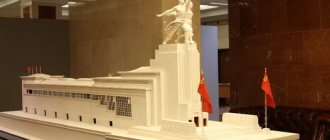Paleontological Museum named after. Yu.A. Orlov in Moscow is one of the largest natural history museums in the world. Four exhibition zones, including six halls of the Dinosaur Museum, are dedicated to the evolution of the organic world of the Earth. Children, and adults too, love to look at exhibits of the ancient world, plunging into the era of dinosaurs.
Courtyard of the Moscow Dinosaur Museum
Huge natural history museum with dinosaur skeletons and exhibits on evolution. The exhibition complex is an integral part of the Paleontological Institute of the Russian Academy of Sciences. A great place to spend a holiday with family and friends.
Photo gallery
In parallel with the 3D tour, you can listen to the Audio Guide for different halls at this link https://clck.ru/Js4TZ
Orlov Paleontological Museum in Moscow: description, reviews and photos
Paleontological Museum named after. Yu.A. Orlova is considered one of the largest and most significant natural history museums in the global paleontological community. The history of the object dates back to the 18th century; it is closely connected with the creation of the Kunstkamera. And, although many people talk about the organization and appearance of the museum, today it is recognized as one of the most visited attractions in the capital.
Mongolia, the nature of sleep and more in virtual mode
Video tour of the exhibition “Mongolia, far and near”
Mongolia is distant, close and very mysterious. The curator of the exhibition, Dmitry Miloserdov, will talk about the nature of this country and the significant contribution Russian researchers made to its study, and will also introduce the work of the Mongolian complex biological expedition, the 50th anniversary of which the exhibition is dedicated to.
Viewers will see with their own eyes what an expedition camp of modern scientists looks like, and what unusual animals inhabit this region.
Take a tour now:
Excursion to the exhibition “Mongolia, far and near.” Dmitry Miloserdov Video: Darwin Museum
Lecture “Carnivorous plants”
The head of the FLOWERRR project for breeding carnivorous plants, Sergei Kunitsyn, gave a lecture and spoke about the content and lifestyle of sundews, Venus flytraps and nepenthes.
Video tour of the exhibition “In the Embrace of Morpheus”
Senior researcher at the Darwin Museum Anna Alexandrova, who is also the author of the exhibition, explores the nature of sleep. She will answer important questions: why do you need sleep? Do everyone sleep the same or differently? Who is more efficient - “larks” or “night owls”?
The exhibition introduces modern theories of sleep and the results of its research over the past half century. And at the same time, the author will tell you whether there is a rational grain in popular myths. For example, that a cup of coffee can replace sleep or that it is especially productive to cram notes the night before an exam.
Tour of the museum's top exhibits
Here you can see the blue-eyed white tigress Kali, an albino squirrel, an anteater, a proboscis monkey, a platypus, the installation “Wolves Attacking a Moose” and a coral reef.
Everyone can see the main exhibits of the museum online. Photo: Vladimir VELENGURIN
"Revived" ancient animals
They are 500 million years old and represent the fossil fauna of the Burgess Shale. They were brought to life using virtual reality technologies. Look at the unusual creatures that once inhabited our planet long ago. There is also a short video of them.
History of construction
The museum was founded back in 1937, when paleontology received a powerful impetus for development. Since 1966, the object was given the name “Palaeontological Museum named after Yu.A. Orlov" - in honor of the outstanding paleontologist and zoologist, who served as director of the museum for 21 years.
For more than a century of existence, the Orlov Paleontological Museum has been closed more than once and the location of exhibits has been changed. Now the object is located in the building at Profsoyuznaya, 123. Despite the fact that it is almost on the outskirts of the city, the spectacle is worth the time spent on the road: a building in the modernist style, reminiscent of a medieval red brick fortress with four corner towers, can take you back in time anyone who enters it. Construction of the facility began in 1972 and lasted until the opening of the museum in 1987. This “long-term construction” will be of interest to anyone who is interested in 20th-century architecture. – it has reached us almost unchanged. The last architect who worked on the project was Y. Platonov.
Now the Paleontological Museum named after Orlov is included in the Paleontological Institute of the Russian Academy of Sciences.
Description of the collected collection
During its existence, the museum's exhibition was expanded to more than 5,000 exhibits, located by topic in 6 huge halls with a total area of 4,500 m2. The collection is dedicated to a detailed overview of the evolution of the organic world of planet Earth. Not a single era or group of animals and plants is ignored. Here you can admire predators, herbivores, marine life and plants, and various fossils. The exhibition includes both originals of giants who lived millions of years ago and casts (copies).
The first hall is the introductory part; dedicated to the theory and methodology of paleontological research. To interest visitors, the first impressive skeleton, belonging to a mammoth, was placed here.
The second hall is from the Precambrian and Early Paleozoic eras. Then the formation of the main types of living organisms took place, as well as their evolution from marine forms to those that can live on land. The focus is on the giant valves of the tridacna mollusk.
The third hall is dedicated to finds on the territory of the Moscow region and its paleontological history, and the fourth is dedicated to the formation of the vertebrate class.
Anyone who would like to visit the museum for the thrilling sight of huge skeletons is advised to go straight to the fifth hall. It houses exhibits from the Mesozoic era - “the time of giant lizards.”
The sixth and final hall is a collection of knowledge about the origin and development of man according to Darwinian theory.
Dinosaurs in the ocean: Moskvarium at VDNKh invites you to a scientific and entertainment festival
A scientific and entertainment festival for everyone who is partial to dinosaurs will be held in the Moskvarium at VDNKh. From March 1 to 8, the second floor of the Center for Oceanography and Marine Biology will turn into an interactive platform with thematic areas. They will work for visitors free of charge. Every day from 11:00 to 18:00, guests will be able to attend creative master classes on creating crafts in the form of dinosaurs, do face painting, take pictures against the backdrop of a three-meter megalodon jaw, play board games “Evolution”, “Dino” and “Oceans” under the guidance of professional game technicians, take part in lectures and animation programs.
Open meetings with scientists and researchers are organized on stage. Especially for the festival, Moskvarium ichthyologists prepared a new lecture for children and adults, “Ancient Inhabitants of the Ocean,” about animals that are generally considered living fossils: marbled protoptera, armored pike, arapaima, sturgeon fish and horseshoe crabs. You can attend the lecture from March 1 to 5 from 16:00 to 16:45 daily, from March 6 to 8 from 11:30 to 12:15 and from 17:00 to 17:45 daily.
On the opening day of the festival and on the weekends, guests will be treated to a scientific show on the topic of paleontology and archeology (March 1 - from 15:15 to 16:00; from March 6 to 8 - from 13:15 to 14:00).
Also on these days there will be a live-action animation program “Mysteries of the Jurassic Period” (March 1 - from 16:45 to 17:30; from March 6 to 8 - from 12:15 to 13:15).
From March 6 to 8 (from 15:00 to 17:00 daily) a dino quest will be organized for young guests. Participants will have to hide from an angry parasaurolophus, feed raptor cubs, save a nest with future offspring of a tyrannosaurus, arrange real excavations and find the remains of ancient reptiles.
In addition, a new permanent exhibition, Jurassic Ocean, will open, dedicated to the age of dinosaurs. For the first time, 12 species of prehistoric giants have been recreated in one exhibition using multimedia technologies: the largest lizard on the planet, the mosasaurus, the prehistoric sperm whale Leviathan, the giant shark Megalodon, the “king of lizards” Basilosaurus, the reptiles Elasmosaurus and Pliosaurus, the sea cow, the mollusks Parapusosius and Endoceras, the racoscorpion Megalograptus and predatory fish Xiphactina and Dunkleostea.
Models of prehistoric individuals ranging in size from three to 20 meters are created in life size in full accordance with the latest scientific research. 3D animation technologies made it possible to achieve realistic and natural animal movements. The giants swim past the panoramic walls, react to visitors, interact with each other and demonstrate the story of their origin. In an interactive form, guests get to know the animals, learn about their size, habitat and period of residence, behavior and other interesting features.
The exhibition is divided into several thematic zones. There you can find a panoramic tunnel with an interactive floor, platforms for simulating volcanic eruptions, an interactive map of the world, watch animals in their natural habitat, and take a trip on a submersible to the coral reef greenhouse. In the interactive “Laboratory” area, with the help of six touch screens and a projection wall, visitors have the opportunity to independently conduct experiments with DNA and develop new species of animals by crossing aquarium fish with prehistoric giants. A team of 50 specialists - directors, composers, sound, lighting and video engineers, designers, artists and paleontologists - worked on the exhibition for more than a year.
The exhibition is located on the second floor of Moskvarium and will be open daily from 10:00 to 22:00. More information about the exhibition can be found on its official website.
You can buy tickets using the link.
For those who stay at home, the events of the scientific and entertainment festival program will be available on March 3 and 5 in online format on the Moskvarium pages on social networks, as well as on its YouTube channel.
The Moskvarium Center for Oceanography and Marine Biology opened at VDNKh in August 2015. Over 12 thousand marine and freshwater inhabitants live here - sharks, seals, stingrays, turtles, caimans, otters, octopus and hundreds of species of fish. The area of the complex is more than 53 thousand square meters, and the aquariums hold about 25 million liters of water.
Preventative measures continue to be taken at VDNKh. Visitors must maintain social distancing and must wear masks and gloves indoors.










